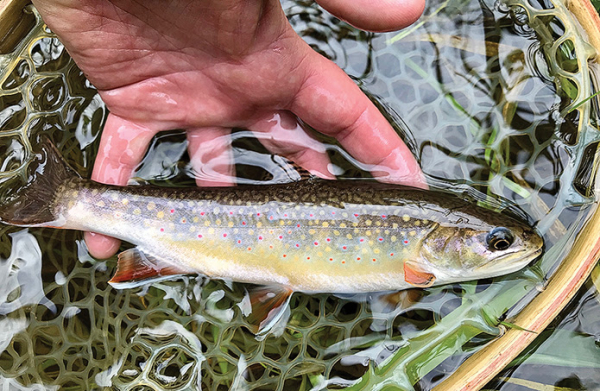Groups Work to Stop Brook Trout from Being the Fish That Got Away
 |
- By Ad Crable, Bay Journal
About 100 days a year, you will find Michael Garrigan by himself with a fly rod, sneaking along small mountain streams hoping to catch and hold, just for a few seconds, a small trout widely revered as the jewel of freshwater fish.
This wild brook trout was caught using an artificial fly in a Pennsylvania mountain steam. (Michael Garrigan)
It’s not just the haloed dots, shadings and multi-hued colors of the wild brook trout that enthrall anglers like Garrigan, of Marietta, PA, though that would be reason enough. “They’re wild and they’re native. There’s something innately beautiful about that,” Garrigan said. “There’s a special allure finding water that has brook trout in it. It’s usually the most remote and close to wild you can be in Pennsylvania. There’s that connection to something that is of that place.”
Recognition of wild brook trout — the East Coast’s only native trout — as an important cultural, recreational and economic icon has never been stronger. Scientists and policy makers also point to the brook trout as an indicator of water quality in streams that eventually feed the Chesapeake Bay.
“Saving brook trout is saving the Bay in a big way,” said Alan Heft, a state fisheries biologist and brook trout program manager for the Maryland Department of Natural Resources.
Brook trout are found along the Appalachian Mountains from Georgia to Maine. They are the state fish of nine Eastern states, including Pennsylvania, New York, Virginia and West Virginia, all of which are in the Bay watershed.
Yet “brookies” are gone from an estimated 60% of their historical range in the Bay’s drainage, mainly because of human development and competition from the nonnative and more aggressive brown trout and rainbow trout. Incredibly sensitive to pollution and sedimentation, one study found that the brook trout is doomed if even 1.5% of its watershed is covered by impervious surface.
Brook trout also depend on cool water, and their scientific name means “dweller of springs,” indicating their reliance on colder temperatures. Their precarious state has worsened as forest loss and climate change warm the streams where they live. The widespread loss of hemlocks, which shade many headwater streams, to a nonnative pest called the woolly adelgid has also depleted brook trout habitat. The lacy green trees were once so synonymous with the fish that they often were called hemlock brook trout.


 Advertising
Advertising